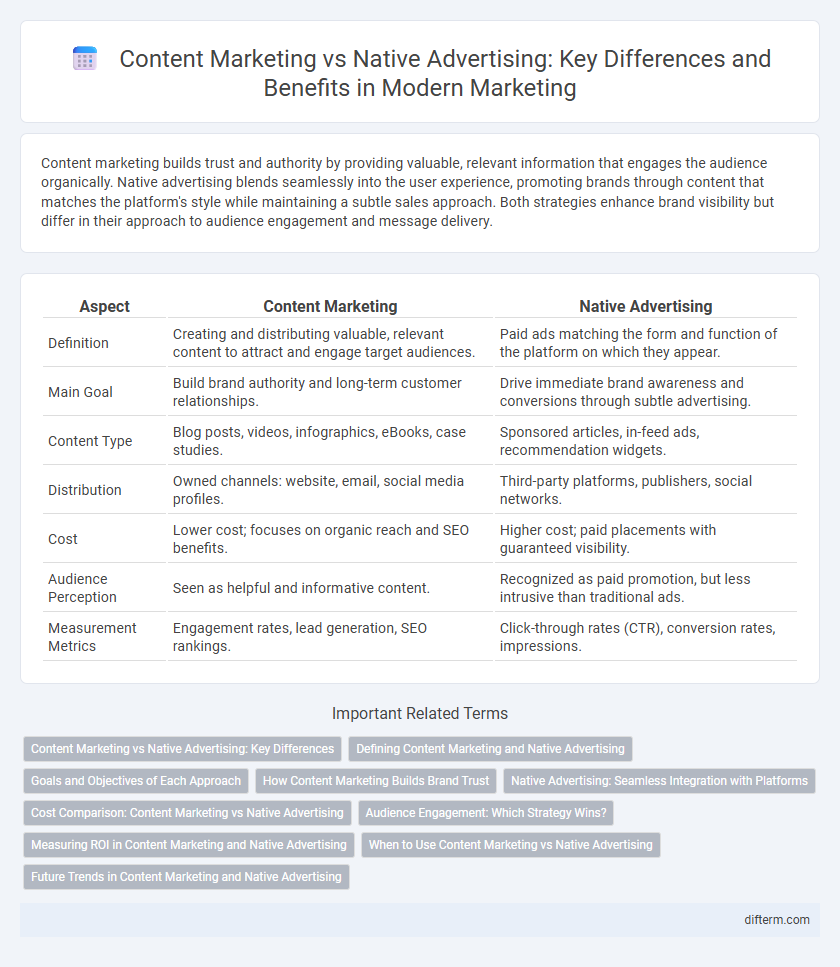Content marketing builds trust and authority by providing valuable, relevant information that engages the audience organically. Native advertising blends seamlessly into the user experience, promoting brands through content that matches the platform's style while maintaining a subtle sales approach. Both strategies enhance brand visibility but differ in their approach to audience engagement and message delivery.
Table of Comparison
| Aspect | Content Marketing | Native Advertising |
|---|---|---|
| Definition | Creating and distributing valuable, relevant content to attract and engage target audiences. | Paid ads matching the form and function of the platform on which they appear. |
| Main Goal | Build brand authority and long-term customer relationships. | Drive immediate brand awareness and conversions through subtle advertising. |
| Content Type | Blog posts, videos, infographics, eBooks, case studies. | Sponsored articles, in-feed ads, recommendation widgets. |
| Distribution | Owned channels: website, email, social media profiles. | Third-party platforms, publishers, social networks. |
| Cost | Lower cost; focuses on organic reach and SEO benefits. | Higher cost; paid placements with guaranteed visibility. |
| Audience Perception | Seen as helpful and informative content. | Recognized as paid promotion, but less intrusive than traditional ads. |
| Measurement Metrics | Engagement rates, lead generation, SEO rankings. | Click-through rates (CTR), conversion rates, impressions. |
Content Marketing vs Native Advertising: Key Differences
Content marketing focuses on creating valuable, relevant content to engage and retain a target audience, building long-term trust and brand loyalty. Native advertising seamlessly integrates promotional messages into the platform's content, designed to match the look and feel of the surrounding media without disrupting user experience. Key differences include content marketing's emphasis on education and relationship-building versus native advertising's goal of immediate brand exposure through sponsored placements.
Defining Content Marketing and Native Advertising
Content marketing involves creating and distributing valuable, relevant, and consistent content to attract and retain a clearly defined audience, aiming to drive profitable customer action. Native advertising seamlessly integrates promotional messages within the natural content format of a platform, making the ads appear less intrusive and more engaging. Both strategies prioritize audience relevance but differ in execution, with content marketing focusing on long-term relationship building and native advertising emphasizing subtle promotional placement.
Goals and Objectives of Each Approach
Content marketing aims to build long-term brand awareness and customer engagement through valuable and relevant content, enhancing trust and loyalty. Native advertising focuses on immediate conversions and brand visibility by seamlessly integrating promotional messages within the user's content experience. Both approaches prioritize aligning with audience interests but differ in timing and directness of marketing outcomes.
How Content Marketing Builds Brand Trust
Content marketing builds brand trust by delivering valuable, relevant information that addresses customer needs and pain points, establishing the brand as an authoritative source. Consistent, high-quality content fosters long-term relationships, encouraging consumer loyalty and repeat engagement. Unlike native advertising, which often blends promotional messages within paid placements, content marketing prioritizes genuine value, enhancing credibility and authenticity.
Native Advertising: Seamless Integration with Platforms
Native advertising offers seamless integration with digital platforms by blending promotional content within the user experience, making it less intrusive and more engaging. This approach enhances ad relevancy and user interaction by matching the format, style, and tone of the surrounding content. By leveraging platform-native elements, native advertising drives higher click-through rates and improves brand affinity compared to traditional display ads.
Cost Comparison: Content Marketing vs Native Advertising
Content marketing generally requires a lower initial investment, leveraging in-house resources to create articles, blogs, and videos with ongoing SEO benefits. Native advertising, however, involves higher upfront costs due to paid placements on premium platforms and targeted audience segmentation, which can generate faster but short-term visibility. Evaluating ROI is crucial as content marketing delivers long-term organic growth while native advertising drives quicker traffic at a potentially higher cost.
Audience Engagement: Which Strategy Wins?
Content marketing fosters deeper audience engagement by delivering valuable, relevant information that builds trust and loyalty over time. Native advertising blends seamlessly with platform content, generating higher click-through rates but often lacks the sustained interaction found in content marketing. Marketers aiming for long-term relationships should prioritize content marketing, while native advertising suits short-term visibility and immediate audience impact.
Measuring ROI in Content Marketing and Native Advertising
Measuring ROI in content marketing involves tracking engagement metrics such as time on page, social shares, and lead generation to assess the long-term brand value and customer relationships. Native advertising ROI measurement prioritizes direct response metrics like click-through rates (CTR), conversion rates, and immediate sales impact due to its paid placement within platforms. Both strategies require leveraging analytics tools and attribution models to optimize spend and maximize return based on specific campaign goals in digital marketing.
When to Use Content Marketing vs Native Advertising
Content marketing is ideal when building brand authority through informative articles, blogs, or videos that engage audiences over time and foster trust. Native advertising suits campaigns aiming for immediate exposure by seamlessly integrating promotional messages within platform-specific formats like social media feeds or sponsored articles. Marketers should choose content marketing for long-term relationship building and native advertising for targeted, high-impact visibility within relevant media environments.
Future Trends in Content Marketing and Native Advertising
Future trends in content marketing emphasize AI-driven personalization and immersive experiences like AR and VR to boost audience engagement. Native advertising is evolving toward seamless integration with editorial content, leveraging data analytics for hyper-targeted campaigns. Both strategies increasingly rely on transparency and authenticity to build trust and long-term customer relationships.
content marketing vs native advertising Infographic

 difterm.com
difterm.com